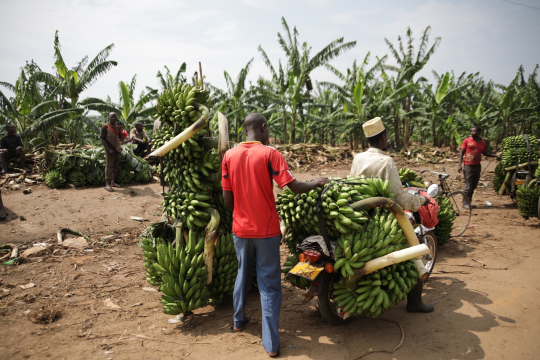Carbon pricing is an important instrument. In the Global South, however there is a risk of malnutrition and deforestation if poor people are not compensated. A new study by EfD and MCC researchers calculates how climate protection and development can go hand in hand.
Climate protection through carbon pricing wouldn’t be a big deal in terms of money in Uganda. The country, with a population of around 50 million, would collect just 26 million US dollars annually if fossil fuels were priced at 40 dollars per ton of CO2. But the seemingly tiny burden of 3 dollars per household annually reduces emissions by 18 percent.
More firewood is used
At the same time, however, the food situation worsens if the burden is not compensated for, with people eating around half as much fruit and vegetables, for example. And they collect a tenth more firewood, accelerating the already threatening deforestation, endangering biodiversity. This scenario is presented by the Berlin climate research institute MCC (Mercator Research Institute on Global Commons and Climate Change) in the journal Environment and Development Economics.
“In our model study, supported by empirical data, we show how climate policy in a low-income country in sub-Saharan Africa affects the economic welfare of private households,” reports Raavi Aggarwal, who led the study as a doctoral student in the MCC working group Climate and Development, and who is now working as a Visiting Assistant Professor at the Indian Statistical Institute in Delhi and an EfD International Associate Researcher.
All are affected by indirect price increases
“Carbon pricing in Uganda will affect energy demand, how biomass is used and the quality of nutrition in a different way than in industrialized countries – this is important to know for sustainable policy and has been little researched so far.”
The research team uses a so-called EASI consumption demand model, with data from Ugandan statistics on the spending structure of private households and the prices of goods, as well as the country’s CO2 emissions by economic sector as determined by the Global Trade Analysis Project research network. Econometric methods are then used to assess how the assumed carbon price of 40 dollars would affect private households, and how they would react to it. Only a minority is directly affected: one in three households has access to kerosene, the fossil fuel most commonly used in Uganda for cooking, and only one in six has access to electricity. By contrast, all households feel the indirect effects through the production costs of other goods, such as food.
Can lead to unbalanced diet
Unlike in industrialized countries, the distributional effects of carbon pricing in Uganda are progressive overall: high-income households bear a greater burden in percentage terms. Relative to spending on energy and food, the model study shows a 12 percent burden on the richest households and a 1 percent burden on the poorest half. The demand for kerosene and electricity drops by 20 percent and 11 percent, respectively, with people switching to firewood and charcoal for cooking and heating. In terms of nutrition, demand for cereals, which are produced with relatively low carbon emissions, nearly doubles, and demand for meat, fish, and vegetables falls by over 50 percent and for fruit by 15 percent. You can do without meat and fish – but this radically unbalanced diet leads to a 20 to 30 percent lower intake of proteins and micronutrients, which the study accurately reflects for both rich and poor, urban and rural populations.
“From an economic point of view, carbon pricing is indeed the most efficient form of climate protection for the Global South as well,” emphasizes Jan Steckel, working group leader at MCC and co-author of the study.
“But from a development policy perspective, it is only an option if the revenues are somehow paid back to the population.”
Urgent action is needed
The model study calculates a variant with the entire revenue redistributed in the form of a uniform per-capita payment, in which the negative effects disappear for most of the population.
“Organizing something like this in practice is still the subject of further research, but subsidies for emission-free cooking stoves, for example, have proven to be effective. In any case, time is of the essence: whether the world meets the Paris climate targets will be determined in the Global South.”
Reference of the cited article:
Aggarwal, R., Ayhan, S., Jakob, M., Steckel, J., 2024, Carbon pricing and household welfare: evidence from Uganda, Environmental and Development Economics
https://doi.org/10.1017/S1355770X24000214
Originally published by MCC, used by permission.
